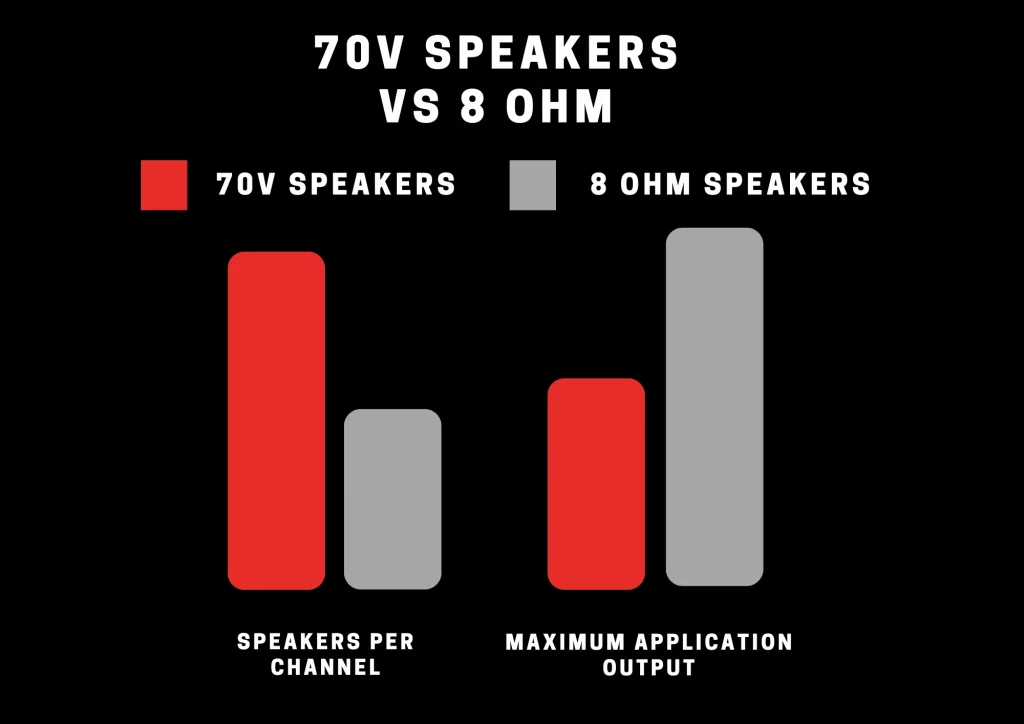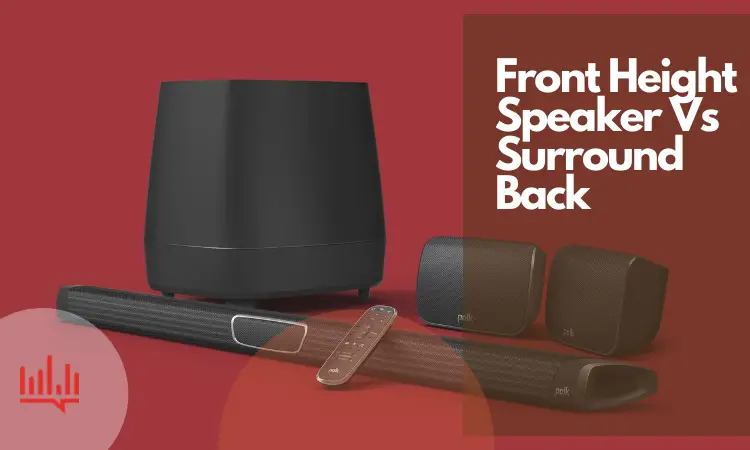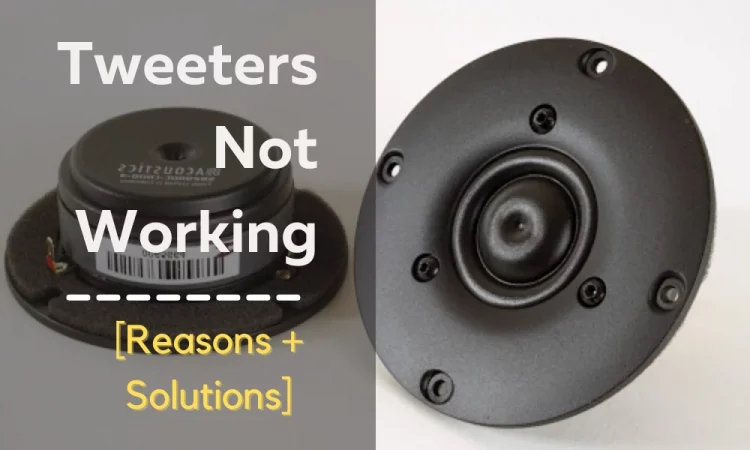Choosing the best sound system as per your preference can be pretty confusing. There are a lot of factors to consider.
But which one should you go for between 70 V speaker VS 8 Ohm?
70V speakers produce high bass and crispy music. But their wiring system is the best for spreading the sound for more than 4 speakers. On the other hand, 8 Ohm speakers are for confined rooms where high-quality sound is required. They require less power and are less expensive.
Are you still confused? Don’t worry, we have your back. We’ve explained all the comparison factors and given a final verdict. To know more, let’s dive right in.
What Do 70 V Speakers and 8 Ohm Speakers Mean?
You must have a lot of queries about 70V speakers and 8 ohm speakers.
Well, before we go into the comparison, let’s take a sneak peek at these speakers for a better understanding.
70V Speakers
Every speaker has an impedance rating in ohms. This indicates how difficult it is to power the speaker. The lower the impedance, the more efficient the electric signal.
This essentially means the music that’s allowed to pass through the speaker. The impedance load of a typical loudspeaker system should match the amplifier’s operational range.
So, what does 70v speaker mean?
70v speaker system is a technology that allows a user to connect multiple numbers and combinations of speakers of different sizes speakers to a circuit. This means that the total wattage demand from the amplifier will not exceed a maximum of 70V wattage. So, the load is specified.
But exactly how many speakers on a 70v system can you manage?
You can connect 10 speakers of 15 watts or 25 speakers using 5 watts in a 70v system. A 70v system allows you to install speakers that can consume around 150 watts.
Some of the 70V speakers most popularly used are Product x and product y.
8 Ohm Speakers
A traditional speaker system consists of one or more speakers. They have an impedance of 8 Ohm, 4 Ohm and 16 Ohm speakers. These speakers are the most common.
An 8-ohm speaker system can consume twice the amount of power that a 4-ohm speaker absorbs.

The impedance is calculated by how much load a speaker will place on an amplifier. An 8 Ohm amplifier specifies the load impedance range allowed with the max output at various loads. For 8 ohm, the maximum amplification output is 215W.
For example, an amplifier’s specifications might state that it can handle different speaker combinations. That range can be from 4 to 16 Ohms. Any speaker setup that places a load outside of this range can cause the amplifier to be damaged.
Here’s what an 8 ohm speaker user has to say-
Head to Head Comparison
There are several factors depending on which your choice of these two speakers can vary. Here, we have given a short comparison of the main features here.
| Features | 70 V Speakers | 8 Ohm Speakers |
| Power calculation | By adding wattage of each added speaker below 70 V | Depends on parallel or series wiring |
| Performance | Degraded sound quality with low frequency and preferred for multi installation | High sound quality with a range of frequency and significant bass used for confined spaces needing high performance |
| Speakers per channel | 4 | 1-2 |
| Speaker Wire Length | Long | Short |
| Maximum Application Output | 180 watts | 215 watts |
So rather than explaining the technical jargon out of context, let’s dive deep in comparing the products depending on categories.
Number of Speakers Connected
For 70 V, a single channel requires 4 or more speakers. On the other hand, it can have speaker lines of more than 75 feet.
In a multi-room arrangement, for example, a 70V system is used. This is when you want independent volume controls for each speaker. 70V volume controls can be installed just before a speaker’s step-down transformer.
These volume controls are far more dependable and safe for your amplifier. It’s better than traditional speaker-level controls. The stronger the case for a 70V system becomes the more speakers you want to use on a single amplifier channel.
Other elements, such as extremely long speaker wire runs, will also support a 70V system. Wiring 70 volts speaker is easy as it allows great flexibility and range when it comes to the connection.
On the other hand, an 8-ohm speaker system offers advantages in systems. This is with only one or two speakers per channel. Such as in a standard home theater setup. They would also lessen your expense and complexity.

Also, they deliver a better quality of sound and louder bass. This is as they are less in number but the performance is high.
So, for speakers, 70V is obviously the one to choose when you are going to connect multiple speakers.
Sound Quality
70v speakers are suitable for speaking with a mic and low-level music applications. Their lower impedance audio offers a wider frequency range. However, there’s a limited frequency range for the 70v line.
For this reason, they’re not ideal for the foreground. They are also not quite good for high-power, or HiFi audio reproduction.
Their power is limited as they can only be given 70V of power. The quality of the audio is proportional to the transformers’ quality. This is because all of your audio will pass via these transformers.
If you try to buy a high-quality, high-power 70-volt transformer, you’ll have to pay more money for one.
You’ll see, if you have an 8-ohm speaker at home, its power range isn’t constant. It’ll only be at that power level for a small fraction of its active time. And mostly fluctuates.
Impedance varies depending on what you’re playing. A speaker rated at 8 ohms could be of 5 ohms, 17 ohms, or even 41 ohms. Because the frequencies drive that component of the constantly changing power range, it’s all over the place.

An 8-ohm speaker will travel from its lowest to the highest range of power. The range has the lowest point (which could be 3 ohms) up to approximately 50 ohms. The peak drops as the frequencies ascend.
This is until you reach the next set of frequencies in the higher bass range. A similar, but smaller peak can be found between 50 and 100 Hz.
With 8 ohm speakers, the third peak frequency is at 2 kHz. As the frequencies rise, a slope will arise at 200 Hz. Eventually, it’ll cascade to a final point. That is around 20% smaller than the original point formed in the low bass.
Hence we suggest, if you’re going for 8-ohm ones, you must not skip these best ones-
So for sound quality, 8-ohm speakers produce high-quality sound and have a wide range of frequencies.
Power Range
Usually, 70v is used in the US and 100V in other parts of the world. This is because of a constant voltage distributed sound system.
You don’t need to use a difficult combination of parallel and series wiring. The installer who is doing the work only needs to sum up the wattage of each speaker.
Just make sure that the total is less than the 70v amplifier’s power output.
Wiring of 70 V can be structured in a much simpler manner. Generally, a daisy chain is used making installation a pleasure.
The maximum output power of an 8-ohm speaker is 215 watts. When you connect the speakers in series, the resistance is measured in ohms. The resistance of the speakers is cumulative.
For example, connecting two 8-ohm speakers in series results in a 16-ohm load. A 4 Ohm load is created by connecting two 8 Ohm speakers in parallel. All of the speakers have the same resistance.
Calculating the effect of a resistive load is simple. To wire a 4×12 cabinet in Series/Parallel with four 8 Ohm speakers, the total load is 8 Ohms. The common (0 volts) and 8-ohm taps would be connected to an 8-ohm speaker.
The power range of both the speakers varies so here we’ll call it a tie.
Usage
The majority of 70-volt distributed speaker systems are used for low-quality audio applications. That is like background music or paging. It’s mainly used when you need more than 4 speakers to connect music.
70-volt distributed loudspeaker systems can usually be found in supermarkets, hotels, hospitals, and airports. It’s used in places where there are more than a dozen speakers installed. This 70 v speaker maybe a few hundred watts.
Most speakers have a transformer that can only handle 5 or 10 watts. So, a variety of speakers can be connected. Product X and Y are known to have the most effective sound quality for malls and hotels.
We use an 8-ohm system where high-end performance is necessary.
For example, it can be used in churches or amphitheaters. This is where we have more control over speaker lines and amplifier distribution.
Also when it comes to a classroom setting, 8 ohm systems are often less expensive. It works well for rooms of 50 people or less. Obviously, this describes the majority of classes.
Well, here we have discussed the uses in detail. You can choose the one suitable for you as per your requirement of the speaker.

Cost
Cost can be a great concern when it comes to which speaker to choose. Because an 8-ohm speaker does not require a transformer and they are cheaper. In short, 8-ohm speakers are the perfect fit in a tight budget ranging between $8-40.
On the flip side, a 70V system adds up the cost of transformers. The cost per speaker might range from $50-300.
It depends on whether you use large transformers for a longer low-frequency response. Many loudspeakers come with built-in 70V transformers.
So, if you are on a tight budget, 8-ohm speakers are the ones for you.
Can an 8 Ohm be Connected to a 70 V Speaker?
No, connecting a 4 ohm or 8-ohm speaker to a 100-volt line or 70-volt line speaker cord is not recommended.
4-8 ohm speakers short circuit the speaker line and overload the amplifier. Also, they significantly overload the speaker which may burn it out. Because amplifiers are restricted by current output.
Thus, if you connect an 8-ohm speaker to the amplifier’s 70V output, you’ll be able to play it at low volumes without issue. But you’ll never get close to the amplifier’s full output capacity. However, if you want to run 8-ohm speaker to a 70v amp, you might want to use 8 ohm to 70v transformer.
But is it possible to connect 70v speaker on 8 ohm amp?
Yes, you can connect 70v speakers on 8 ohm amp as long as you have voltage swing left. For 8 ohm amps, it’s 600watts of power consumption. So you shouldn’t have any issue in the way of connecting 70v speakers to your 8 ohm amp.
Which Speaker Should You Go For?
To determine which speaker to choose depends on your implications.
If you want a speaker for your bar or restaurant that doesn’t need good quality music. For those uses, go for a 70 V speaker. It will also cost you less.
But if you want one for a bigger space, go for an 8-ohm speaker. Such as an in-house auditorium or classroom where the sound quality is a big factor. But their longevity is something that varies on many factors.
FAQs
Here are some common questions you might be thinking of while reading our article. You can go through the question below to solve them.
Is higher impedance better?
No, it does not. The impedance indicates how difficult it is to power the speaker. The lower the impedance, the more efficient the electric signal. This essentially in music, is allowed to pass through the speaker. Again, the lower the speaker’s impedance, the more power it will demand from your receiver.
Do higher watts mean louder?
Yes, more watts do mean “louder” in general. Higher power (wattage) is significant because it means a louder and clearer sound. So, many artists simply examine the amplifier’s power or wattage rating. However, a small variation in power doesn’t make much of a difference in terms of audibility.
How many watts is necessary for 8 ohm speakers?
A speaker with 8 ohm impedance requires an amplifier capable of producing around 700 watts into an 8 ohm load. Also, the amplifier must possess 700 watts per channel for a pair of stereo speakers.
Conclusion
That is all from us on 70 V speakers vs 8 Ohm. You can choose the best one but always keep your usage in mind before buying. We are glad that you have come this far. If you have any queries, do let us know.
Till then, have a good day!



